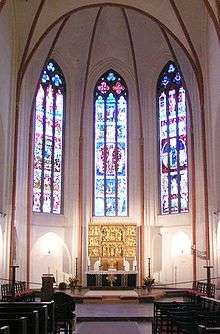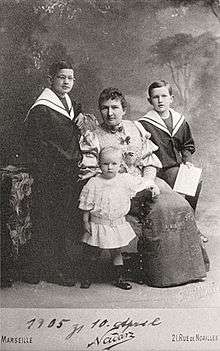Charles Crodel
| Charles Crodel | |
|---|---|
 One of Crodel's stained glass paintings at St.-Jacobi, Hamburg.Germany | |
| Born |
September 16, 1894 Marseille |
| Died | November 11, 1973 (aged 79) |
| Nationality | German |
| Known for | Painting, Stained glass art |
Charles Crodel (September 16, 1894 – November 11, 1973) was a German painter and stained glass artist who also taught at Penn State University and the University of Louisville.

Life
Crodel was born in Marseille, he studied arts at the University of Jena, while he became painter and lithographer. He was member of the executive board of the Jena art-union, the famous forum of the Bauhaus, and became a close friend of Gerhard Marcks. In 1923, the German National Gallery of Art at Berlin and later the Bibliothèque Nationale at Paris bought first his woodcuts and lithographies. A mural in the University of Jena, another in the Weimar Schlossmuseum and a third in Erfurt remain of that time.
From 1927 on, Crodel taught printing and monumental painting at the "Burg Giebichenstein", the Academy of Arts and Crafts in Halle until 1933 when he was dismissed, but he continued to teach in a private cricle at the house of Paul Frankl. In these years, Crodels murals in Halle and the murals dedicated to Goethe in 1932 at Bad Lauchstädt were destroyed in summer 1933 and in 1936. At this time many refugees brought Crodels paintings and prints, which now are found at Louisville, The North Carolina Museum of Art, Raleigh, the Virginia Museum of Fine Arts and the Luther College, Decorah.
The following years Crodel found new fields of work. He designed glass decoration in Industry (together with Wilhelm Wagenfeld),[1] and he explored pottery decoration together with Hedwig Bollhagen, while Elisabeth Crodel completed embroidery.
Bollhagen had acquired a pottery business from a Jewish artist who had been forced to sell.[2] Bollhagen worked closely with Crodel who had been ejected from the gleichgeschaltet (Nazi sympathetic Arts organisation) group for creating Degenerate art. Crodel's friendship was said to be important to Bollhagen.[3] Crodel also began to paint stained-glass and to design mosaics.
In 1945, Crodel again taught at Halle, but also at Berlin and Dresden, and from 1951 at the Bavarian State Academy of Fine Arts in Munich. From 1958 on Crodel also several times was invited to the Penn State and Louisville Universities.[4]
Stained glass
.jpg)
Crodel's stained-glass windows are found in Germany and in Sweden. Beautiful examples are found in the Frankfurt city churches,[5] Alsfeld, Kaulsdorf (Berlin), Königs Wusterhausen, Heinersdorf, St. Jacobi, Hamburg, St. Mary's Church, Fuhlsbüttel, Hamburg, St. Matthew's Church, Hamburg, St. John's Church, Lüneburg, Schmalkalden.
Coming from a session of the Berlin Academy of Arts, Crodel died in 1973 in Munich, at the age of 79.
Exhibitions
University of Louisville: Allen R. Hite Art Institute: Paintings and Graphic Work by Charles Crodel, October 6–28, 1958. Introduction by Justus Bier[6] and Senta Bier.
Portraits
- Walter Hasenclever, lithography, 1920.
- Theodor Daeubler, lithography, 1921.
- Wilhelm Worringer and Herbert Koch, woodcut, 1922.
- Die Töpferin Marguerite Friedlaender, painting, Berliner Sezession, 64. Ausstellung: Künstler unter sich. Malerei. Plastik. April / März 1931.
References
- ↑ https://sites.google.com/site/charlescrodel/crodel-glas
- ↑ Margarethe Loebenstein und Hedwig Bollhagen, deutschlandfunk.de, retrieved 14 April 2014
- ↑ Hedwig Bollhagen, FemBio.org, retrieved 14 April 2014
- ↑ "Archived copy". Archived from the original on 2005-12-01. Retrieved 2005-11-02.
- ↑ "Archived copy". Archived from the original on 2005-10-30. Retrieved 2005-11-02.
- ↑ Justus Bier